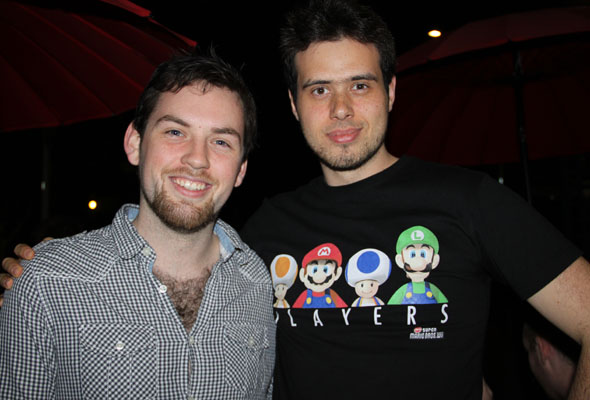Developers prepare for game-making challenge
This month Australian game developers will go head-to-head in the annual 48 Hour Game Making Challenge in Brisbane. Despite the changing and somewhat uncertain landscape of the industry, the event sees a healthy turnout every year and is a great opportunity for participants to tests their skills under pressure. Among the teams registered are last year’s indie category winners, Rockin’ Moses (pictured).
This September, the Queensland University of Technology will be hosting the 48 Hour Game Making Challenge to promote development within the local games industry. Now in its sixth year, the competition challenges teams of programmers to create a fully playable video game within just two days.
Teams are divided into two separate groups – “indie” and “pro” – and formulate ideas using three keywords which are revealed to participants once the event begins.
“Basically they get a bunch of computer geeks together in a huge hall,” said Rocco Loria, whose team won the challenge last year with their game The Fifth Suit. “They supply us with a table, a power cable and that’s about it. We supply everything else. Then we set up, we bunk in, and they [the competition’s judges] deliver us the three words.”
Not knowing the keywords before the challenge means that participants are required to construct ideas quickly and under pressure. Similarly, teams that utilise keywords in clever and inventive ways are in for a better chance of winning.
“That’s the trick – to not just use the words as a flavour element on top,” said Gaute Rasmussen, who lectures at QANTM College and was one of the judges from last year. “You can very easily relate the words to story or something like that, but if you can use every single word for an actual game-play mechanic, that’s what will impress.”
Emphasis on creativity and thinking outside the box is vital to performing well, but with the onset of what industry experts call “franchise fatigue,” it might be easier said than done. Compared to the late ‘90s when new gaming genres were constantly being invented, Mr Rasmussen believes it’s hard to be unique by today’s standards.
“In defence of repetitive games, we’ve discovered the majority of gaming genres that there are and now we’re just playing around with what we already know,” said Mr Rasmussen. “There’s still different ways of putting those together, but I don’t think we can expect to keep seeing the same degree of novelty that we saw 10 years ago.”
Morgan Jaffit however, who is creative director at Defiant Development, believes Australia is starting to see more creative games given the steady closures of local, mid-sized studios and the emergence of mobile and tablet gaming.
“I think that without a shakeup in the industry we wouldn’t see as many interesting projects happening as there are at the moment,” said M. Jaffit. “There are a lot of people doing really cool stuff and if you take all those people from those [closed] studios and split them up, you get a lot more projects out of them.”
“It might take 60 to 100 people to ship a console game and it may take three or four years. All the creativity of those people is tied up during that time so it’s been nice to see what happens when that creativity has been put on to the market.”
In this regard, the competition closely mirrors the local industry in that participants are required to create bite-sized games under a compressed development cycle. But does it prepare them for the real thing?
“Absolutely,” says Mr Loria, whose team Rockin’ Moses will be competing again this year. “It just goes to show what you and a small amount of people can accomplish with a bit of time and dedication. A good game idea is a good game idea. If a game is fun, it comes from a good idea and that can be achieved in a very short timeframe.”
Mr Rasmussen however, is a little more cautious.
“In terms of team sizes I think it is pretty spot on,” he said. “You can have six people in a team in the 48 Hour and a lot of the smaller games that we see are even smaller than that. So if you can do the challenge it sets you up well.”
“Having said that though, this is just 48 hours and a very small experience so there’s quite a big step up from that to making proper games for commercial sales.”
That’s not to say that the next step is impossible. The 2008 winning team, SIF90, had two of its developers go on to create the wildly successful Fruit Ninja which was released on tablet devices and has since been ported to Facebook and Xbox Kinect. According to gaming website Joystiq, the game has surpassed 20 million downloads following its release two years ago.
Of course to replicate this success would be a lofty goal, but developers should be inspired rather than discouraged. According to Mr Rasmussen, success in today’s industry is more achievable than it has ever been before.
“I think that it’s easier in a way to get into the industry now because the old industry required you to get past Microsoft or Nintendo or Sony,” he said. “Now you can just make a game on your own and submit it to Apple and you’re good… You don’t have to be part of a big studio anymore.”
This is particularly good news for aspiring game developers. In fact, if making a solid game can give you a shot in the industry, the 48 Hour challenge might just be the perfect place to start.
The 48 Hour Game Making Challenge takes place on September 28-30 at QUT Kelvin Grove, Creative Industries Precinct.
Photo courtesy of Laura Arnaud, used with permission.

